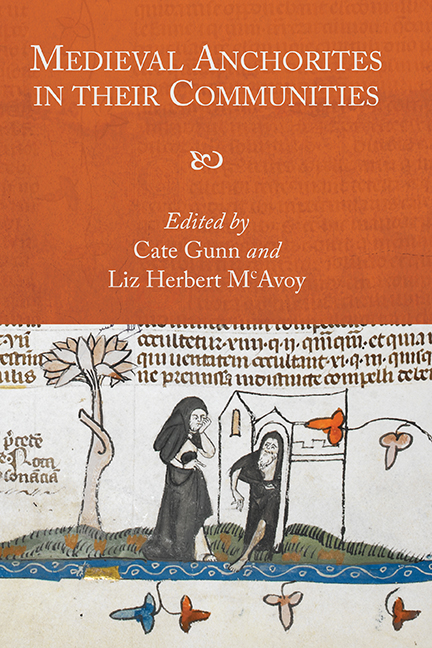Book contents
- Frontmatter
- Dedication
- Contents
- List of Illustrations
- Acknowledgements
- List of Contributors
- Abbreviations
- Introduction: ‘No Such Thing as Society?’ Solitude in Community
- 1 ‘O Sely Ankir!’
- Part I Religious Communities
- Part II Lay Communities
- 5 English Nuns as ‘Anchoritic Intercessors’ for Souls in Purgatory: The Employment of A Revelation of Purgatory by Late Medieval English Nunneries for Their Lay Communities
- 6 ‘In aniversaries of ower leoveste freond seggeth alle nihene’: Anchorites, Chantries and Purgatorial Patronage in Medieval England
- 7 ‘Item receyvyd of ye Anker’: The Relationships between a Parish and its Anchorites as Seen through the Churchwardens’ Accounts
- 8 The Curious Incident of the Hermit in Fisherton
- 9 Was Julian's Nightmare a Māre? Julian of Norwich and the Vernacular Community of Storytellers
- Part III Textual Communities
- Bibliography
- Index
- Miscellaneous Endmatter
9 - Was Julian's Nightmare a Māre? Julian of Norwich and the Vernacular Community of Storytellers
from Part II - Lay Communities
Published online by Cambridge University Press: 30 August 2017
- Frontmatter
- Dedication
- Contents
- List of Illustrations
- Acknowledgements
- List of Contributors
- Abbreviations
- Introduction: ‘No Such Thing as Society?’ Solitude in Community
- 1 ‘O Sely Ankir!’
- Part I Religious Communities
- Part II Lay Communities
- 5 English Nuns as ‘Anchoritic Intercessors’ for Souls in Purgatory: The Employment of A Revelation of Purgatory by Late Medieval English Nunneries for Their Lay Communities
- 6 ‘In aniversaries of ower leoveste freond seggeth alle nihene’: Anchorites, Chantries and Purgatorial Patronage in Medieval England
- 7 ‘Item receyvyd of ye Anker’: The Relationships between a Parish and its Anchorites as Seen through the Churchwardens’ Accounts
- 8 The Curious Incident of the Hermit in Fisherton
- 9 Was Julian's Nightmare a Māre? Julian of Norwich and the Vernacular Community of Storytellers
- Part III Textual Communities
- Bibliography
- Index
- Miscellaneous Endmatter
Summary
THE scene would not be amiss in a horror film: a young woman is shown sleeping peacefully, when suddenly a monstrous creature appears – half-human, half-animal, with an emaciated face and shaggy hair – that grabs the woman by the throat with his claws. Baring his many teeth at her with a mocking grin, he furiously tries to strangle her. Instead of a film scene, however, this nightmare is one of the visionary experiences of Julian of Norwich (c. 1343–c. 1416), found in her two writings, A Vision Showed to a Devout Woman – written in the middle of the 1380s – and A Revelation of Love, written between the 1390s and 1416. Though describing the same scene, the two accounts also differ in a striking way: in the later A Revelation Julian expands her description, adding more vivid details, a trend discernible in the entire work. The earlier account, in A Vision, is brief and lacking in detail, or in the words of Liz Herbert McAvoy ‘muted and almost dismissive’; later, however, in A Revelation Julian creates a horrifying scene with highly specific details: the monster and his threatening actions are described by Julian in ‘some of her most vivid and concrete language’.
At first glance, this expanding of a frightening experience in a later text may appear counterintuitive: not only is it unusual that an author would describe her younger self's nightmare in greater detail, but other negative moments, such as a vision of three ‘nothings’, have been removed in A Revelation. However, this scene in A Revelation shows Julian's ability as a narrator to turn a scene suggesting lack of agency into one that reveals her mastery of storytelling and her control over her narrative. I suggest that already in A Vision, but even more so in A Revelation, these scenes evoke folklore narratives in which a supernatural creature tries to strangle a sleeper. A Vision and A Revelation thus illustrate how, in medieval religious culture, ‘folklore’ (or ‘unofficial’ belief) and ‘official’ belief formed part of a spectrum of beliefs, as Carl Watkins suggests: ‘[W]e need to think of medieval religious culture as a commingling of unofficial and official belief that varies over space and time – forming not a series of cultural compartments, but a spectrum.
- Type
- Chapter
- Information
- Medieval Anchorites in their Communities , pp. 147 - 164Publisher: Boydell & BrewerPrint publication year: 2017



